Page 164 of 400
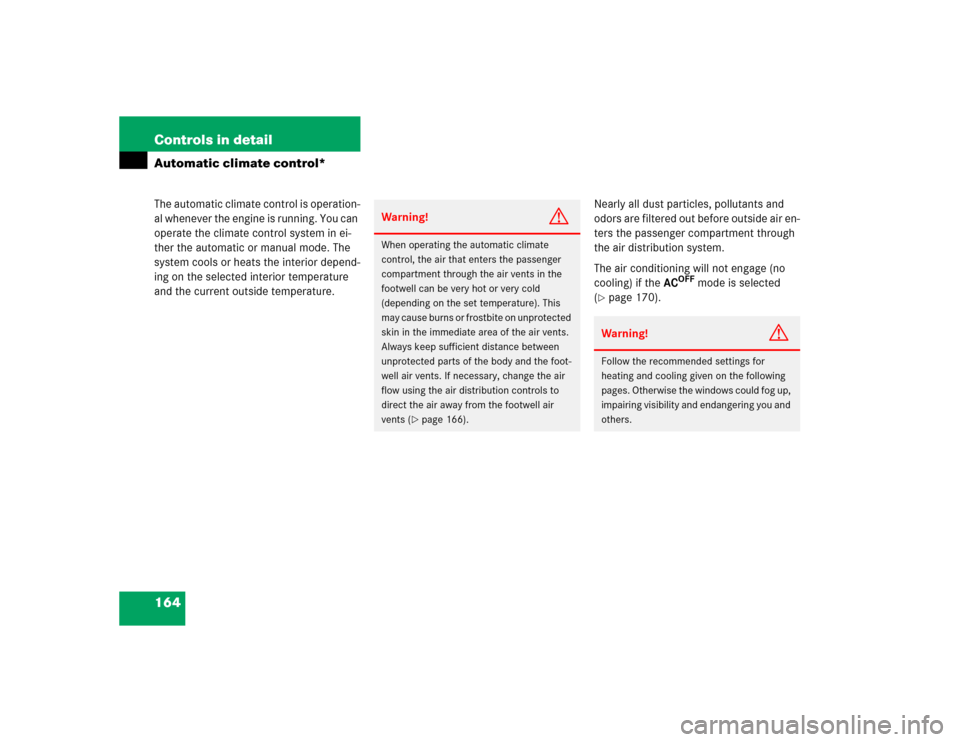
164 Controls in detailAutomatic climate control*The automatic climate control is operation-
al whenever the engine is running. You can
operate the climate control system in ei-
ther the automatic or manual mode. The
system cools or heats the interior depend-
ing on the selected interior temperature
and the current outside temperature.Nearly all dust particles, pollutants and
odors are filtered out before outside air en-
ters the passenger compartment through
the air distribution system.
The air conditioning will not engage (no
cooling) if theAC
OFF
mode is selected
(
�page 170).
Warning!
G
When operating the automatic climate
control, the air that enters the passenger
compartment through the air vents in the
footwell can be very hot or very cold
(depending on the set temperature). This
may cause burns or frostbite on unprotected
skin in the immediate area of the air vents.
Always keep sufficient distance between
unprotected parts of the body and the foot-
well air vents. If necessary, change the air
flow using the air distribution controls to
direct the air away from the footwell air
vents (
�page 166).
Warning!
G
Follow the recommended settings for
heating and cooling given on the following
pages. Otherwise the windows could fog up,
impairing visibility and endangering you and
others.
Page 170 of 400
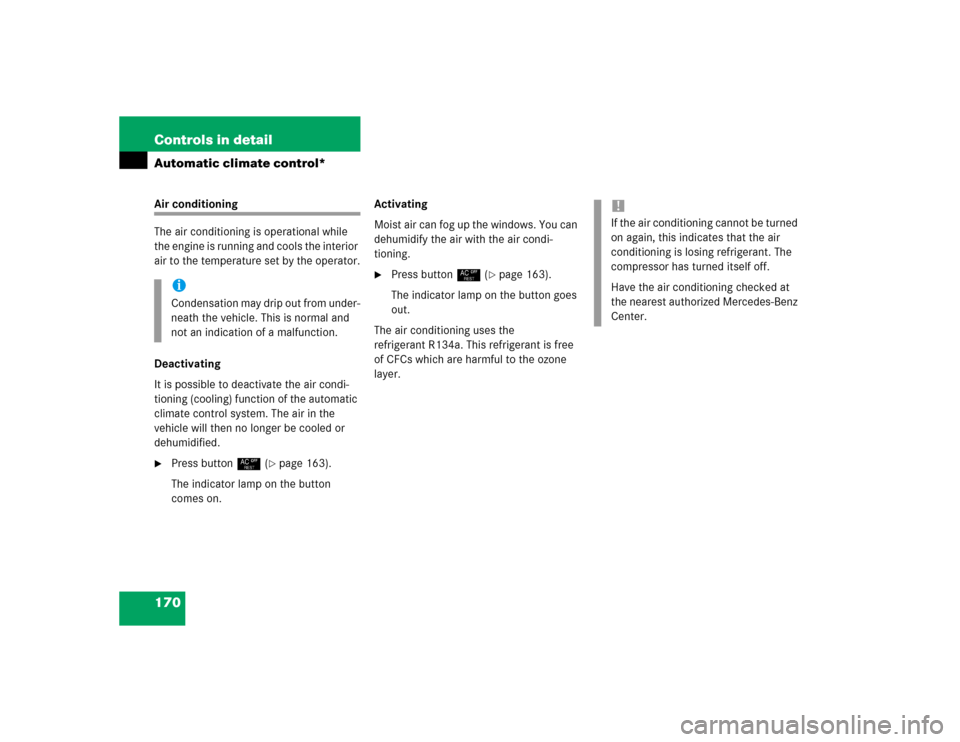
170 Controls in detailAutomatic climate control*Air conditioning
The air conditioning is operational while
the engine is running and cools the interior
air to the temperature set by the operator.
Deactivating
It is possible to deactivate the air condi-
tioning (cooling) function of the automatic
climate control system. The air in the
vehicle will then no longer be cooled or
dehumidified.�
Press button° (
�page 163).
The indicator lamp on the button
comes on.Activating
Moist air can fog up the windows. You can
dehumidify the air with the air condi-
tioning.
�
Press button° (
�page 163).
The indicator lamp on the button goes
out.
The air conditioning uses the
refrigerant R134a. This refrigerant is free
of CFCs which are harmful to the ozone
layer.
iCondensation may drip out from under-
neath the vehicle. This is normal and
not an indication of a malfunction.
!If the air conditioning cannot be turned
on again, this indicates that the air
conditioning is losing refrigerant. The
compressor has turned itself off.
Have the air conditioning checked at
the nearest authorized Mercedes-Benz
Center.
Page 171 of 400
171 Controls in detail
Automatic climate control*
Residual heat and ventilation
With the engine switched off, it is possible
to continue to heat or ventilate the interior
for up to 30 minutes. This feature makes
use of the residual heat produced by the
engine.
Activating�
Turn the SmartKey in the starter switch
to position1 or0, or remove it from
the starter switch.
�
Press button° (
�page 163).
The indicator lamp on the button
comes on.Deactivating
�
Press button° (
�page 163).
The indicator lamp on the button goes
out.
The residual heat is automatically turned
off:
�
when the ignition is switched on
�
after about 30 minutes
�
if the battery voltage drops
iHow long the system will provide
heating depends on the coolant
temperature and the temperature set
by the operator. The blower will run at
speed setting1 regardless of the air
distribution control setting.
Page 207 of 400
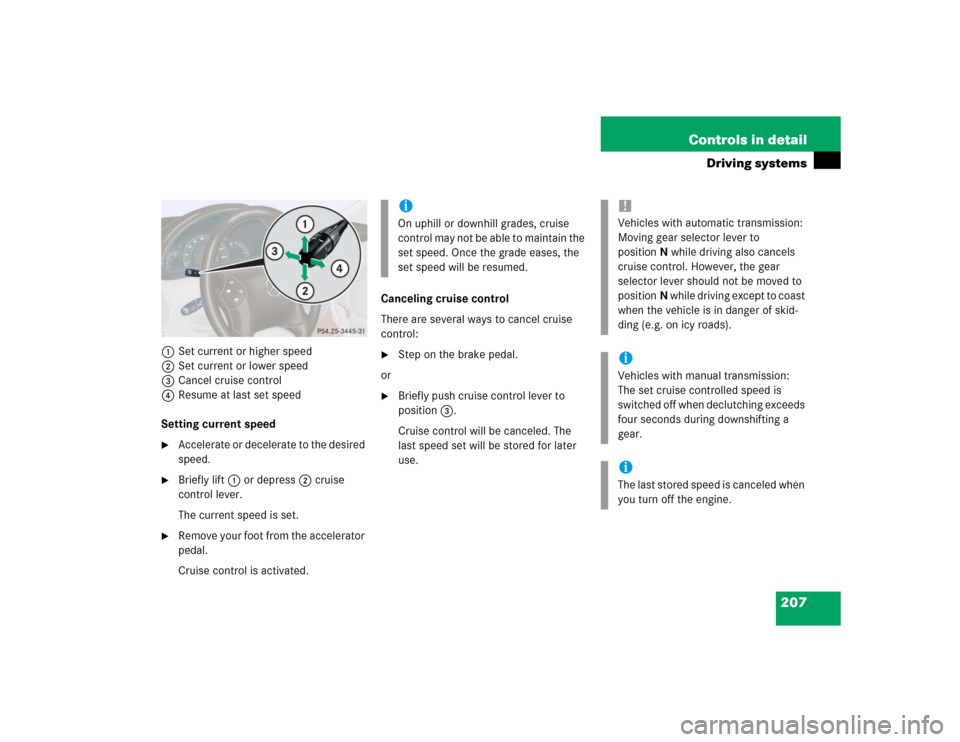
207 Controls in detail
Driving systems
1Set current or higher speed
2Set current or lower speed
3Cancel cruise control
4Resume at last set speed
Setting current speed�
Accelerate or decelerate to the desired
speed.
�
Briefly lift1 or depress2 cruise
control lever.
The current speed is set.
�
Remove your foot from the accelerator
pedal.
Cruise control is activated.Canceling cruise control
There are several ways to cancel cruise
control:
�
Step on the brake pedal.
or
�
Briefly push cruise control lever to
position3.
Cruise control will be canceled. The
last speed set will be stored for later
use.iOn uphill or downhill grades, cruise
control may not be able to maintain the
set speed. Once the grade eases, the
set speed will be resumed.
!Vehicles with automatic transmission:
Moving gear selector lever to
positionN while driving also cancels
cruise control. However, the gear
selector lever should not be moved to
positionN while driving except to coast
when the vehicle is in danger of skid-
ding (e.g. on icy roads).iVehicles with manual transmission:
The set cruise controlled speed is
switched off when declutching exceeds
four seconds during downshifting a
gear.iThe last stored speed is canceled when
you turn off the engine.
Page 208 of 400
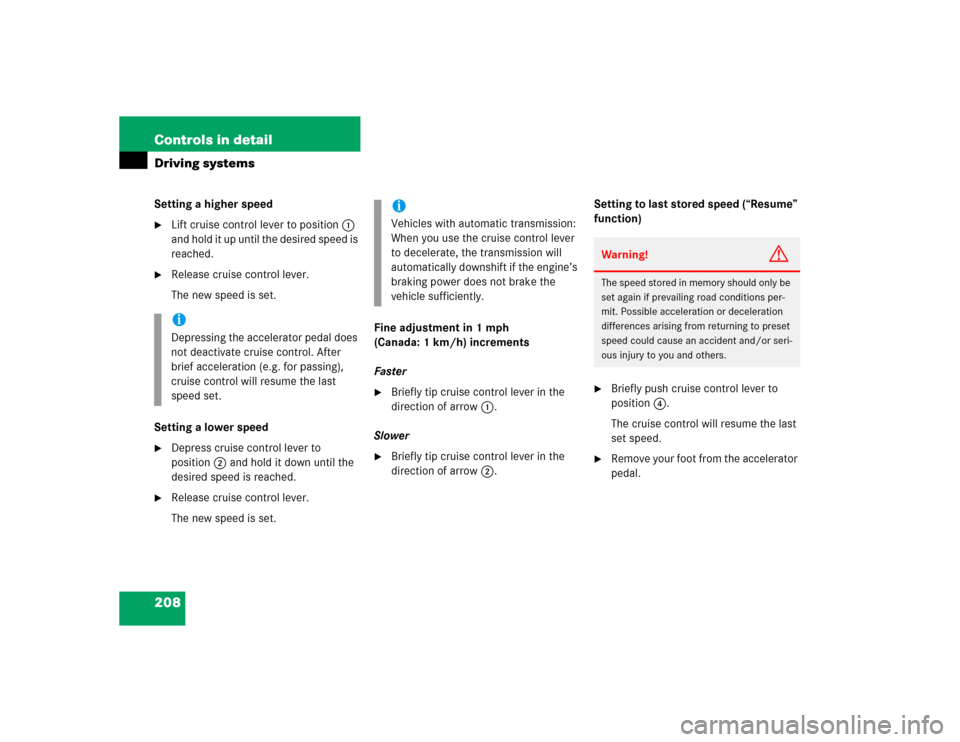
208 Controls in detailDriving systemsSetting a higher speed�
Lift cruise control lever to position1
and hold it up until the desired speed is
reached.
�
Release cruise control lever.
The new speed is set.
Setting a lower speed
�
Depress cruise control lever to
position2 and hold it down until the
desired speed is reached.
�
Release cruise control lever.
The new speed is set.Fine adjustment in 1 mph
(Canada: 1 km/h) increments
Faster
�
Briefly tip cruise control lever in the
direction of arrow1.
Slower
�
Briefly tip cruise control lever in the
direction of arrow2.Setting to last stored speed (“Resume”
function)
�
Briefly push cruise control lever to
position4.
The cruise control will resume the last
set speed.
�
Remove your foot from the accelerator
pedal.
iDepressing the accelerator pedal does
not deactivate cruise control. After
brief acceleration (e.g. for passing),
cruise control will resume the last
speed set.
iVehicles with automatic transmission:
When you use the cruise control lever
to decelerate, the transmission will
automatically downshift if the engine’s
braking power does not brake the
vehicle sufficiently.
Warning!
G
The speed stored in memory should only be
set again if prevailing road conditions per-
mit. Possible acceleration or deceleration
differences arising from returning to preset
speed could cause an accident and/or seri-
ous injury to you and others.
Page 220 of 400
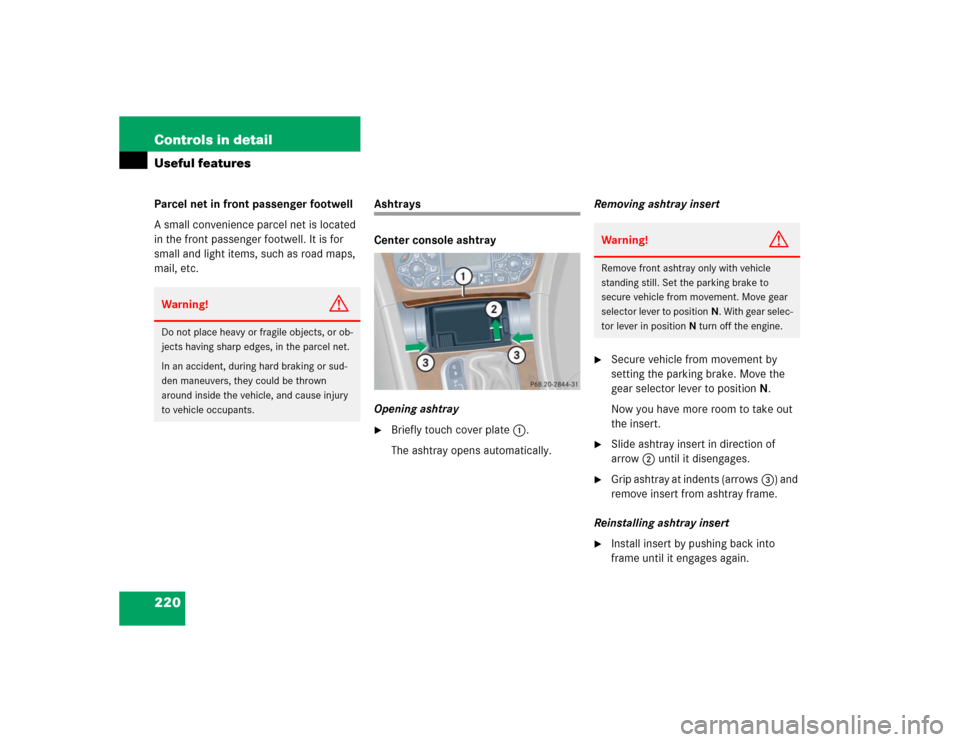
220 Controls in detailUseful featuresParcel net in front passenger footwell
A small convenience parcel net is located
in the front passenger footwell. It is for
small and light items, such as road maps,
mail, etc.
Ashtrays
Center console ashtray
Opening ashtray�
Briefly touch cover plate1.
The ashtray opens automatically.Removing ashtray insert
�
Secure vehicle from movement by
setting the parking brake. Move the
gear selector lever to positionN.
Now you have more room to take out
the insert.
�
Slide ashtray insert in direction of
arrow2 until it disengages.
�
Grip ashtray at indents (arrows3) and
remove insert from ashtray frame.
Reinstalling ashtray insert
�
Install insert by pushing back into
frame until it engages again.
Warning!
G
Do not place heavy or fragile objects, or ob-
jects having sharp edges, in the parcel net.
In an accident, during hard braking or sud-
den maneuvers, they could be thrown
around inside the vehicle, and cause injury
to vehicle occupants.
Warning!
G
Remove front ashtray only with vehicle
standing still. Set the parking brake to
secure vehicle from movement. Move gear
selector lever to positionN. With gear selec-
tor lever in positionN turn off the engine.
Page 222 of 400

222 Controls in detailUseful featuresTelephone*
Radio transmitters, such as a portable tele-
phone or a citizens band unit, should only
be used inside the vehicle if they are con-
nected to an antenna that is installed on
the outside of the vehicle.
T he e x t e r n a l a n t e n n a m u s t b e a p p r o v e d b y
Mercedes-Benz. Please contact an autho-
rized Mercedes-Benz Center for informa-
tion on the installation of an approved
external antenna. Refer to the radio trans-
mitter operation instructions regarding use
of an external antenna.You can take and place telephone calls
using theí andì buttons on the
steering wheel. To carry out other tele-
phone functions, use the control system
(
�page 138).
See separate operating manual for instruc-
tions on how to use the telephone.
Warning!
G
Never operate radio transmitters equipped
with a built-in or attached antenna (i.e. with-
out being connected to an external antenna)
from inside the vehicle while the engine is
running. Doing so could lead to a malfunc-
tion of the vehicle’s electronic system, pos-
sibly resulting in an accident and personal
injury.
Warning!
G
Please do not forget that your primary re-
sponsibility is to drive the vehicle. A driver’s
attention to the road must always be
his/her primary focus when driving. For
your safety and the safety of others, we rec-
ommend that you pull over to a safe location
and stop before placing or taking a tele-
phone call.
If you choose to use the telephone
1 while
driving, please use the hands-free device
and only use the telephone when road,
weather and traffic conditions permit. Some
jurisdictions prohibit the driver from using a
cellular telephone while driving a vehicle.
Only operate the COMAND* (Cockpit Man-
agement and Data System)
1 if road, weather
and traffic conditions permit.
Bear in mind that at a speed of just 30 mph
(approximately 50 km/h), your vehicle is
covering a distance of approx. 44 feet
(approximately 13.5 m) every second.
1Observe all legal requirements.
Warning!
G
Some jurisdictions prohibit the driver from
using a cellular telephone while driving a
vehicle. Whether or not prohibited by law,
for safety reasons, the driver should not use
the cellular telephone while the vehicle is in
motion.
Stop the vehicle in a safe location before
answering or placing a call.
Page 237 of 400
237 Operation
The first 1 000 miles (1 500 km)
Driving instructions
At the gas station
Engine compartment
Tires and wheels
Winter driving
Maintenance
Vehicle care